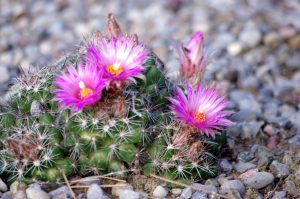Mostly, we think of cacti as house plants. However, the cold-hardy members of this large plant family have the potential for garden use.
They are very showy in outdoor plantings, with beautiful flowers, interesting spines, and a variety of pad coloring
Cacti are occurring throughout North and South America. The greatest concentration of species is found in Mexico, Arizona, New Mexico, and West Texas. We think of cacti as being low desert plants but some are found in Canada. Our native cactus are :
Opunta fragils ; Saskatchewan, southern Manitoba. and western Ont.
Opuntia humifiusa; southern tip of Ontario
Opuntia polyacantha; Plains prickly pears, southern Alberta and southern Saskatchewan, British Colombia, native to the dry interior.
Escobaria vivipara; (pincushion cactus) Native to southern Alberta., southern Saskatchewan. and southwestern Manitoba
Planting and caring for Cacti:
When it comes time to plant your new cacti, most importantly, always plant cacti in full sun and very well-drained soil.
Situating the planting area properly is also important. Locate planting beds in full sun against south and west-facing walls, or in hot, dry areas surrounded by cement sidewalks and driveways. When looking for a planting spot, be sure that a garden bed in full summer sun doesn’t find itself in the shade as the sun drops lower in the winter. Do not plant in a low-lying area, as melting snow/ice or very heavy rains can cause the plants to rot.
If planting rooted and potted cactus, gently loosen the soil and shake it off.
Plant into a shallow hole, spreading the roots out evenly.
Mulch with crushed gravel to a depth of 1 to 2 inches depending on the size of the plant. Don’t worry if the gravel covers some of the spines up from the base of the plant. The mulch will settle with time.
I wait a few days to water in the new plants. This gives the cut roots time to callus over.
When watering cacti, it is better to keep them dryer, than to over water.
However, during the heat of the summer, cacti will respond positively to soaking (especially one’s grown in pots)
When planting unrooted pads you must make sure that cut wound is well callous. Using kitchen tongs, lay the pads on their side and press gently into the soil. Roots will form on the underside of the pad and give it a good start.
Alternatively, stick the pad with a cut end into the soil so that the pad is vertical. The danger in this is that the wound where it was severed from the mother plant could become infected with bacteria or fungus. Erwinia bacteria (potato soft rot) is the common pathogen of newly planted cuttings.
Cacti should be planted in relatively dry soil and not watered in. They can be watered after a couple of weeks.
In spring you can apply a single application of granular fertilizer to your cactus beds.
Sometimes new pads will reward you with flowers the first year. If you lucky there will be fruit called “tuna”. It is time-consuming to clean the fruit, but it is really tasty.
Cactus cross-pollinate very easily so you may end up with some new, interesting garden hybrids.
Little seedlings are really soft and will take a few years for them to reach the flowering stage.
There are two problems with cacti. They are addictive and hard to weed. I use kitchen tongs to pull weeds from my cactus garden.
Cacti are ideal xeric plants, great for dry sunny location when nothing else will grow. They are easy and don’t need too much attention.








